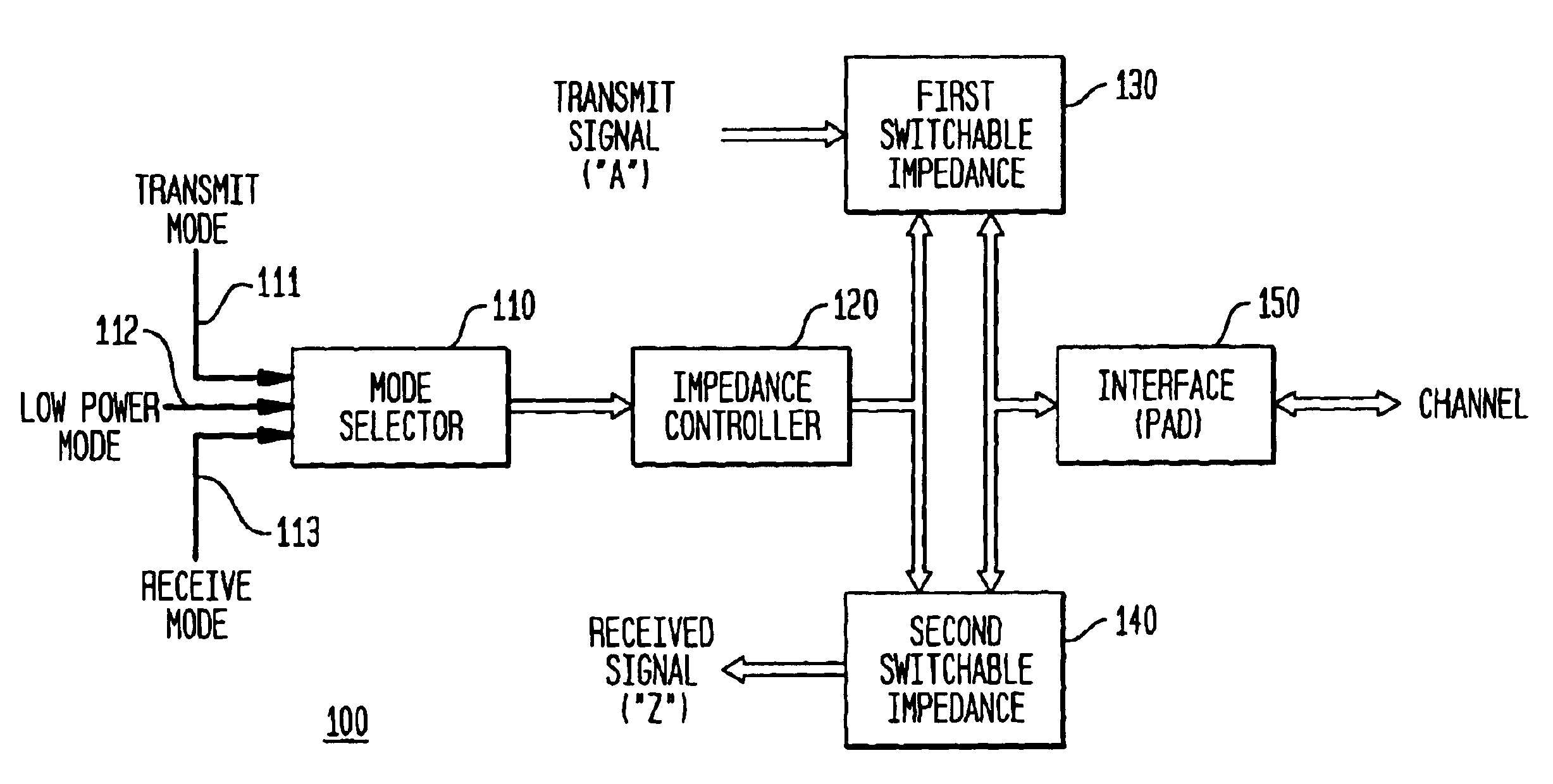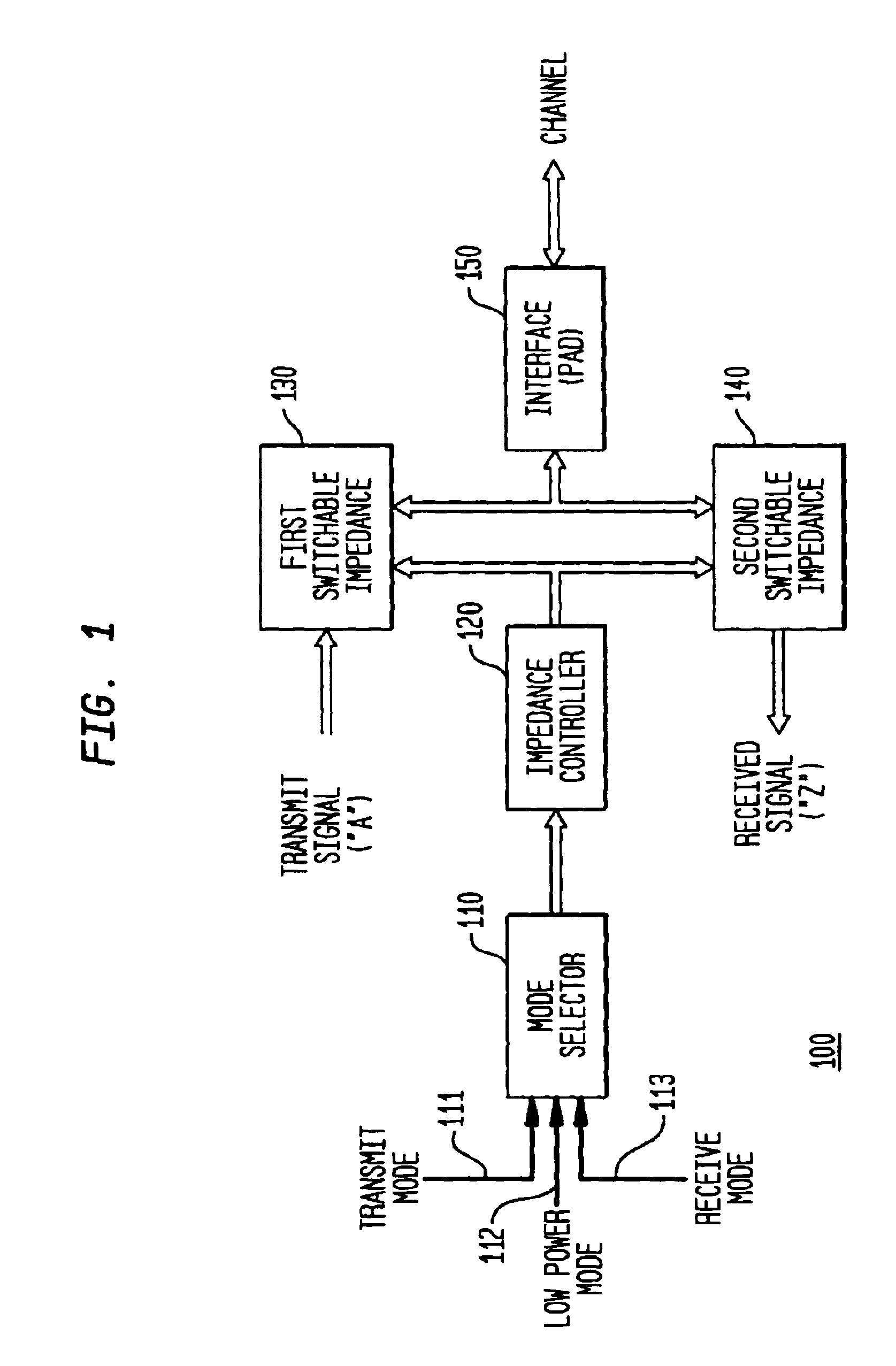Bi-directional impedance matching circuit
a bi-directional impedance matching and integrated circuit technology, applied in logic circuit coupling/interface arrangement, pulse technique, baseband system details, etc., can solve the problems of poor signal integrity of transmitted signals, poor signal integrity of received signals, impedance mismatch between terminating or input impedances, etc., to achieve accurate impedance matching, low power mode, and good or high signal integrity
- Summary
- Abstract
- Description
- Claims
- Application Information
AI Technical Summary
Benefits of technology
Problems solved by technology
Method used
Image
Examples
embodiment 100
FIG. 1 (or “FIG. 1”) is a block diagram illustrating a first exemplary apparatus embodiment 100 in accordance with the present invention. As illustrated in FIG. 1, the apparatus 100 includes a mode selector 110, an impedance controller 120, a first switchable impedance 130, and a second switchable impedance 140. The apparatus 100 is generally couplable to a single interface 150 (also referred to as a “PAD” or input / output (I / O) node), which provides for an electrical interface between the apparatus 100 and the channel (transmission line or external load), for full duplex, digital communication over a channel, such as a communication bus for data transfer between and among ICs.
The apparatus 100 provides three different modes of operation: a transmit (or first) mode, a receive (or second) mode, and a low power or third mode. In the transmit mode, a signal to be transmitted (referred to herein as the “transmit signal”), consisting of digital information (or bits) referred to as “A”, wi...
embodiment 300
FIG. 2 also illustrates a third exemplary apparatus embodiment 300 in accordance with the present invention, as an abbreviated version of apparatus 200. In the event a less complicated or smaller impedance matching circuit is desired (compared to the apparatus 200), portions of the first switchable impedance 230A and 230B may be omitted, namely, transistors M9, M10, M11 and M12, and resistors 240 and 250. In these circumstances, in the transmit mode, when “A” is high, the output impedance is resistor 235 (R1), while when transmit signal “A” is low, the output impedance is R3 (resistor 245). For example, if R1 and R3 are each 100 Ohms, then the output impedance in this abbreviated circuit is 100 ohms. Conversely, for the receive mode, the input impedance is R1 in a parallel combination with R3 which, for this example, would be 50 Ohms. As a result, for this abbreviated apparatus 300, either the input impedance or the output impedance will substantially match the channel impedance; ho...
embodiment 210
In the embodiment 210, the mode selector includes an enable signal input 210; a termination enable signal input 212; a first inverter (X3) coupled to the enable signal input to provide the inverted enable signal; and a second inverter (X4) coupled to the termination enable signal input to provide the inverted termination enable signal.
In the embodiment 220, the impedance controller includes a first transmission gate 255 having an input of a signal for transmission, and is coupled to the mode selector 210 to receive the termination enable signal and the inverted termination enable signal; a NAND gate 265 having a first input 266 coupled to an output of the first transmission gate 255 and a second input 267 coupled to the mode selector to receive the enable signal; a second transmission gate 260 having an input of the signal for transmission, and coupled to the mode selector 210 to receive the termination enable signal and the inverted termination enable signal; and a NOR gate 270 hav...
PUM
 Login to View More
Login to View More Abstract
Description
Claims
Application Information
 Login to View More
Login to View More - R&D
- Intellectual Property
- Life Sciences
- Materials
- Tech Scout
- Unparalleled Data Quality
- Higher Quality Content
- 60% Fewer Hallucinations
Browse by: Latest US Patents, China's latest patents, Technical Efficacy Thesaurus, Application Domain, Technology Topic, Popular Technical Reports.
© 2025 PatSnap. All rights reserved.Legal|Privacy policy|Modern Slavery Act Transparency Statement|Sitemap|About US| Contact US: help@patsnap.com



